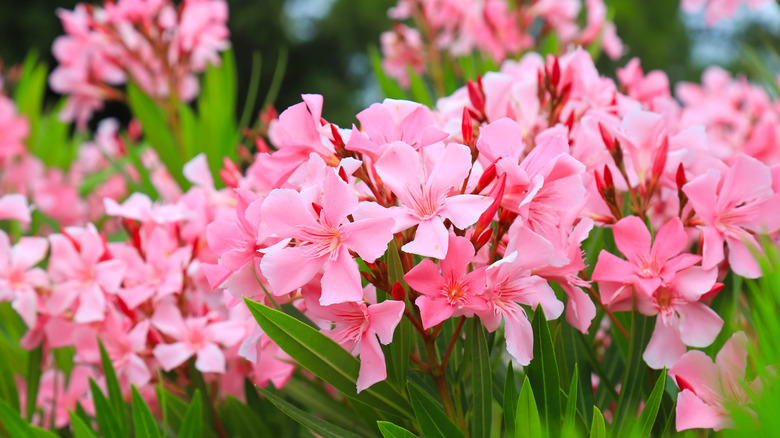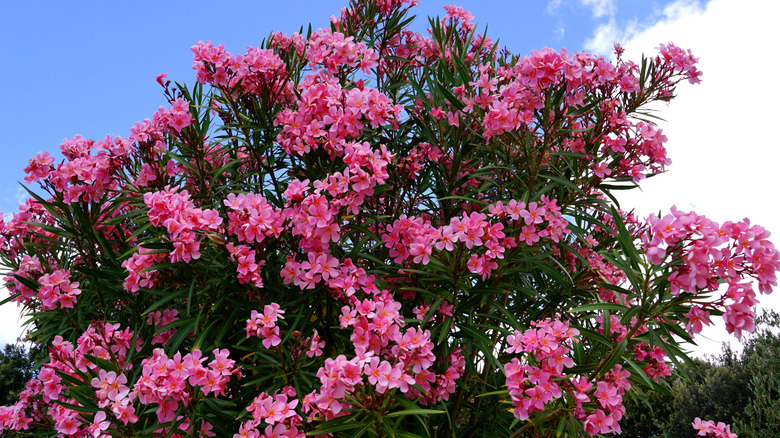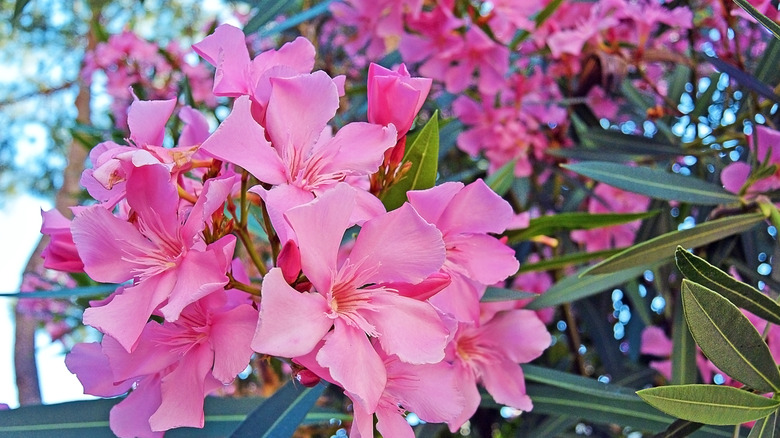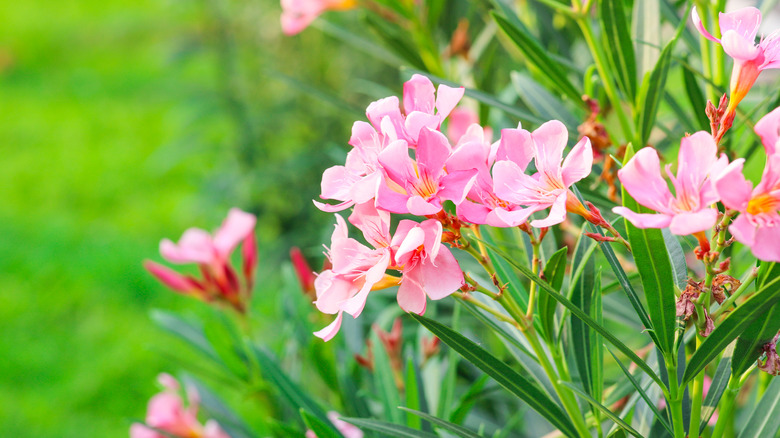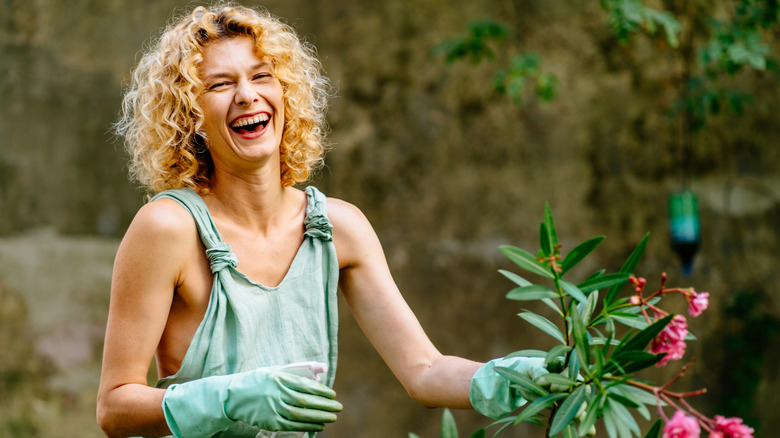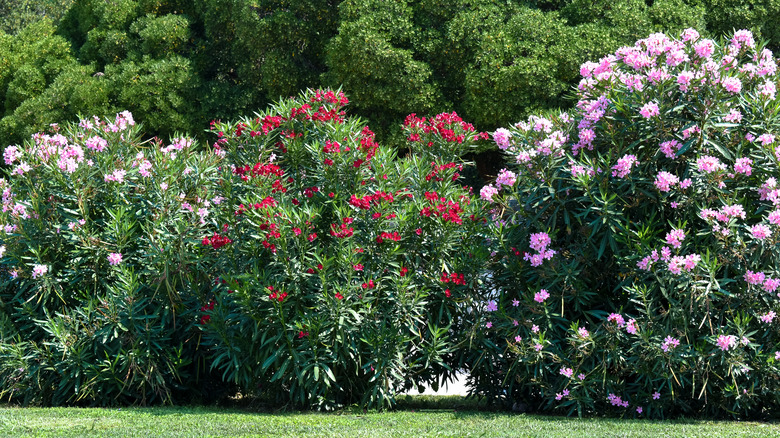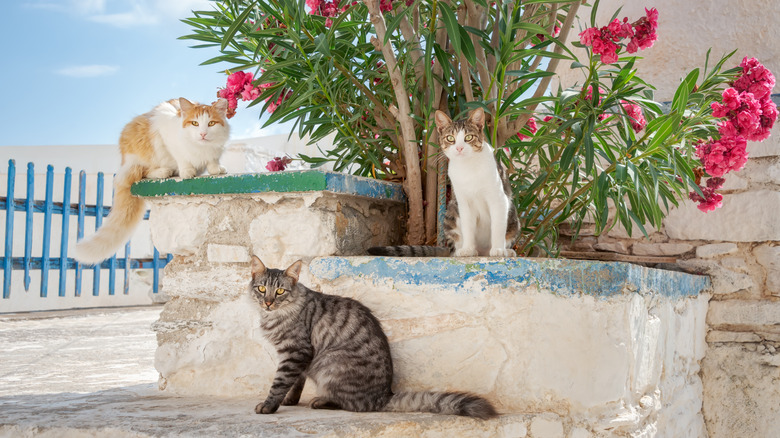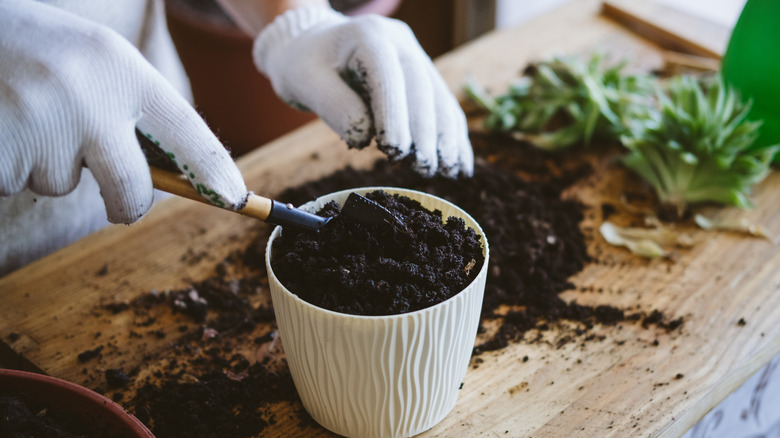How To Grow And Care For Oleander
The Nerium oleander, most commonly called oleander or Nerium, is a widely-cultivated shrub used as an ornament and a landscaping plant. It is so popular that its origin cannot be accurately traced to a particular region, but according to Science Direct, it is usually associated with the Mediterranean.
The oleander is widely identified by its smooth, dark green, thick, and leathery leaves (via Clemson University). Biologically, its leaves are simple and linear in shape, e.g. they are long and narrow, almost like a ruler but with pointed ends. Its five-petaled flowers come in variations of white, pink, red, and yellow. Oleanders are generally easy and quick to grow, too. No wonder they're so popular!
Popularity aside, don't make the mistake of eating oleander because, despite its adorable appearance, it contains substances toxic enough to kill a heifer within hours (via Science Direct). Historically, oleander was used in several regions as a means of inducing abortion and committing suicide as well.
If you or anyone you know is having suicidal thoughts, please call the National Suicide Prevention Lifeline at 1-800-273-TALK (8255).
How to use oleander in a garden
If you wish to plant oleander in your garden, several factors should be taken into consideration; one is their function. If you need an anchor for a garden bed, a single yard specimen, or to line a driveway or walkway, then an oleander can do that for you. Just remember that they are highly toxic (via South Florida Plant Guide).
Another factor to consider is their growth span. Oleanders can grow above 15 feet when mature. They bloom in full sun and any type of soil (but best in neutral soil), and produce a variety of flowers depending on the species. Light shade can be tolerated but fewer flowers will be produced. You also don't need to fear losing your oleander plant when pruned because they regenerate even when killed nearly to the ground (via SF Gate).
Costa Farms suggest giving your oleanders the companions of a fire bush, croton, or plumbago. They grow well with oleanders since they have similar requirements.
How to grow an oleander, part one
FYI, this is going to be a three-stage guide on how to grow an oleander, and this here is the first section. According to Gardener's Path, Nerium can either be cultivated using its stem or seed, but stem cuttings are more accessible and guaranteed to succeed.
Before planting, it is good to know that cultivating in August (summer), when the stem cuttings collected are fresh from vegetation, is the best option. They can be planted any other time if the conditions are suitable, but summer increases the chances of successful growth. Oleanders do not thrive in the winter or weather lower than 20 degrees Fahrenheit, according to Gardening Know How.
The tools needed are simple; you will need garden gloves (to protect your skin from plant toxins), stem cuttings from an oleander (also called sprigs), a sterilized knife, a transparent jar (transparent so sunlight can pass through), and a clay pot (to transfer into once roots form).
How to grow an oleander, part two
Collect oleander stem cuttings for planting. Note that not all sprigs are suitable for cultivation. The best ones are the sprigs that have not flowered yet. Cut 4 inches to 8 inches off of the top of a mature oleander plant (the length of stem depends on the height of the transparent jar used).
Secondly, prepare the stem cutting for propagation by removing all the leaves on the stem except for the upper 1/4 of the cutting. Don't hurt the stem by cutting too deep — instead, leave the buds from the cut leaves (via WikiHow). This promotes root formation
The next step is to nurse the oleander younglings in a jar filled 1/4 with water. You can also put your sprig directly into the soil, but nursing it until the roots grow increases the chances of successful growth, per Gardening Know How. After a month or a few weeks, once a bunch of roots have formed, transfer the stem into a pot.
How to grow an oleander, part three
Remember earlier, when we mentioned how oleander plants don't grow in the winter? According to Gardening Know How, the young, potted oleander plant will remain in its pot until fall (October through November). By fall if your plant is not strong enough to withstand the cold, re-pot it into a bigger plant pot and keep it indoors over the winter — most suitably in a place free from cold temps. Oleander also doesn't require as much water as it did before, so wait until the soil is dry before moderately watering the plant. This will prevent rotting. By spring (March), your oleander will have grown strong enough to be transferred into the ground, as noted by WikiHow.
This final step is delicate because moving fragile plants around may cause strain or stunt their growth. Oleanders are best planted where full sun can reach them and not hidden under shade or below other taller plants, per MasterClass.
How to care for an oleander
Oleanders are admired for their fast and easy growth tendencies, according to Gardening Solutions. Even in their growth stage, they are easy and low maintenance. No wonder cities often use them as landscape ornaments! And, despite its low maintenance, oleander still displays masses of long-lasting and vibrant flowers.
To care for an oleander, moderate watering is required. Overwatering without adequate drainage, however, can lead to rotting and yellowing of leaves. Additionally, India Gardening recommends 10-10-10 granular fertilizer or any fertilizer rich in potassium like vegetable fertilizer. Potted oleander requires fertilizer once every four to six weeks. The soil that oleander is in may lose its nutrients by its first spring in gardens, so it is appropriate to add fertilizer to replenish lost nourishment.
Oleander relies on good sunlight, so maximum sunlight is needed as well. Finally, pinching the young stems of oleanders encourages growth as does pruning, so that should be done after spring when the plant has bloomed, per Gardening Know How.
Varieties of oleander
According to Gardening Know How, there are over 50 species of Nerium oleander for purchase across the globe, each producing different colors of flowers, mainly white, red, yellow, and pink. Pink-flowered oleanders are the most popular; Hardy Pink in particular is very common. It rises to 15 feet and grows to 10 feet in width. If you desire white flowers, Sister Agnes reaches 12 feet in height and grows large white flowers. White Sands, a dwarf version of oleander, reaches about 6 feet in height.
Mathille Ferrer is the most common species of yellow-flowered oleanders. Reaching 15 feet in height, it blooms with double flowers (via MasterClass). Red-flowered oleanders, according to experts at the Clemson Cooperative Extension, are the hardiest among all the species of oleander. Hardy Red is an example that grows to 8 feet and blooms with single, deep red flowers. Other species include Austin Pretty Limits and Twist of Pink.
Is oleander toxic?
According to Science Direct, the entirety of every oleander plant species is poisonous because this plant contains toxic cardiac glycosides. Gardener's Path even warns against inhaling the smoke from a burning oleander. According to Mount Sinai Health System, whenever consumed either by an animal or human, oleander can harm the heart, blood, vision, and digestive system. The nervous system is also affected, which may also cause depression. These symptoms may persist for one to three days before eventually leading to death.
Per a study published by Senaka Rajapakse in 2009 (via the National Library of Medicine), there's no any first aid for oleander poisoning; the best remedy is to seek professional attention as soon as consumed and prevent it from happening by always wearing gloves, long-sleeved shirts, and pants when handling oleanders. Also, cultivating oleanders in landscapes by schools, farms, or homes where children, animals, and pets live is not advised.
How to repot an oleander
When you notice roots seeping out from below the pot, the soil drying up fast, or the plant beginning to wilt, that means you need to re-pot your oleander (via HuffPost). Re-potting gives your plant fresh new soil and more room to grow, but it is also a delicate process that if not done well can kill your plant.
After getting your new and wider pot, turn the oleander plant sideways, hold the stem, and tap the bottom gently to release the plant from the pot. The plant will come with the soil compacted if you watered it two days before. The roots may be wound around the pot, so snip extra-long and rotten roots. Sterilize your scissors after every snip to avoid the transfer of bacteria. Gently place the oleander into the new pot and fill up the remaining space with soil-based compost. It's not best to re-pot during extreme weather like winter, but rather in warm temperatures like in spring (via Gardener's Path).
